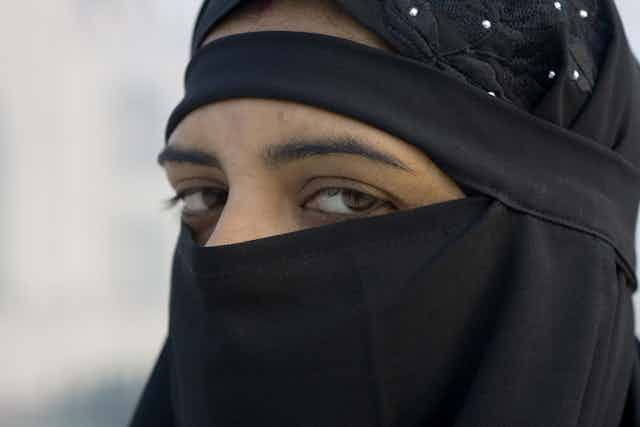Given the reaction of some parts of the media, one could be forgiven for assuming that Europe and the rest of the Western world has become besieged by burqa-clad women. The “fear” is now so rife that empty bus seats in Norway recently were mistaken for a group of women wearing the burqa.
Meanwhile, in a much derided stunt in Australia, far right leader Pauline Hanson wore a full-face covering burqa into the senate chamber. Hanson’s aim was to prohibit Muslim women from covering their faces and to get the burqa banned in the country.
To look at it, the burqa is simply a veil which covers the body and face – and yet it is also sometimes associated with oppression, terrorism, and extreme religious beliefs. Some burqas only have a mesh screen for the wearer to see through. The niqab, on the other hand, is a face veil worn with a headscarf which leaves the eyes uncovered, while the hijab is a scarf which covers the head and neck. In Europe, the term “burqa” is used to refer to women who wear robes to cover the body and face, but their eyes may be left uncovered, as seen in the main image of this article.
Putting aside the contradiction between laws dictating what women can and cannot wear, human rights issues, and the history of women struggling to have the right to choose their own clothing, the number of Muslim women who wear the burqa alone does not necessitate this fear, nor any expense and time in creating new laws to ban the burqa.
The passion to ban the burqa is likely linked to the idea that all Muslims are synonymous with terrorism. This is evidently not the case, but the burqa bans –when coupled with the overestimation of the number of Muslims across Europe – create a sense of being able to curtail the numbers of Muslims, and terror, by controlling what women wear.
Muslims in Europe
In 2011, France became the first European country to ban the burqa. At the time of legislation in 2011, there were 4.7m Muslims in France, making up 7.4% of the population. As of July 2016, Muslims now account for 7.2% of the French population. Legislative documents supporting the ban reported that 1,900 Muslim women wore the face covering burqa in the country in 2011. This number represented 0.04% of the French Muslim population, and less than 0.003% of the general population of France.
However, the 1,900 figure is reportedly a significant over-inflation of the initial figures released by the French secret service, who were charged with collecting this data. It originally found that only 367 women wore the burqa. This represents an even lower percentage of the population: 0.01% of the French Muslim population, and 0.00058% of the general population.
It is almost inconceivable that so much time, effort and cost would be spent bringing in a law that only affected 367 people in a country of over 63m.
The low number of women wearing the burqa in France reflects wider European estimates of Muslim women who cover their faces, where figures are either correspondingly low, or so low as to be impossible to record.

Since the ruling in France, other European countries have followed suit. Belgium also introduced a ban in 2011, which was implemented without any available estimates of how many Muslim women wear the burqa, as the figures were too “marginal”.
The Netherlands approved a partial burqa ban in certain public spaces such as hospitals and schools in 2016. State broadcaster NOS reported the total number of Muslim women that this affects ranges from 100-500, most of whom only occasionally wore it. This equates to 0.01-0.05% of the Muslim population in The Netherlands, and less than 0.003% of the Dutch population – regardless of whether the higher or lower estimate is used.
Bulgaria is home to one of the largest and oldest Muslim communities in Europe, who make up about 12% of the population. Prior to the national ban in 2016, towns had begun to ban it locally, starting with Pazardzhik, which implemented the ban due to the presence of 12 women who wore the burqa, or 0.01% of the town’s population.
In Austria, legislation banning the burqa comes in to force from October 2017. There are thought to be up to 150 women who practice the full face cover, making up 0.03% of the Muslim population, and, again, less than 0.002% of the population.
Studies show that 70% of Muslim women do not cover their hair at all in Germany which has a Muslim population of 5%. Yet despite this, and with no data on burqa wearers, it is following the Netherlands with plans to implement a partial burqa ban.
In the UK, there are no available numbers on how many women wear the burqa but the figures are likely to correspond to the low, virtually immeasurable European figures. Regardless, just as across Europe, there is strong public support for similar legislation: a YouGov survey conducted in 2016 revealed that 57% of the UK population would support a ban. For now, however, there do not appear to be any legislative plans to ban the burqa in Britain.
Banning freedom
It is highly questionable whether the microscopic figures of women who wear the burqa has warranted the inordinate amount of focus, time and cost that has been put into scrutinising it. Fears surrounding the burqa are unfounded and based on perceptions of it posing a threat, despite no evidence of this.
Forcing women to not wear the burqa is no different to the Taliban forcing women to wear it: it removes all control from the woman over her body, and is just part of the sexist narrative controlling women’s dress in public places.

